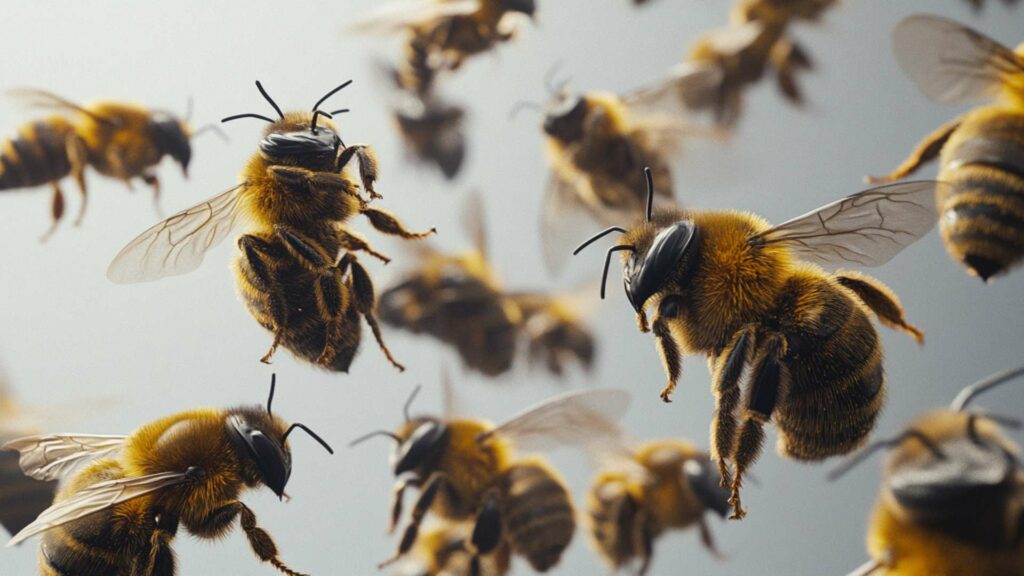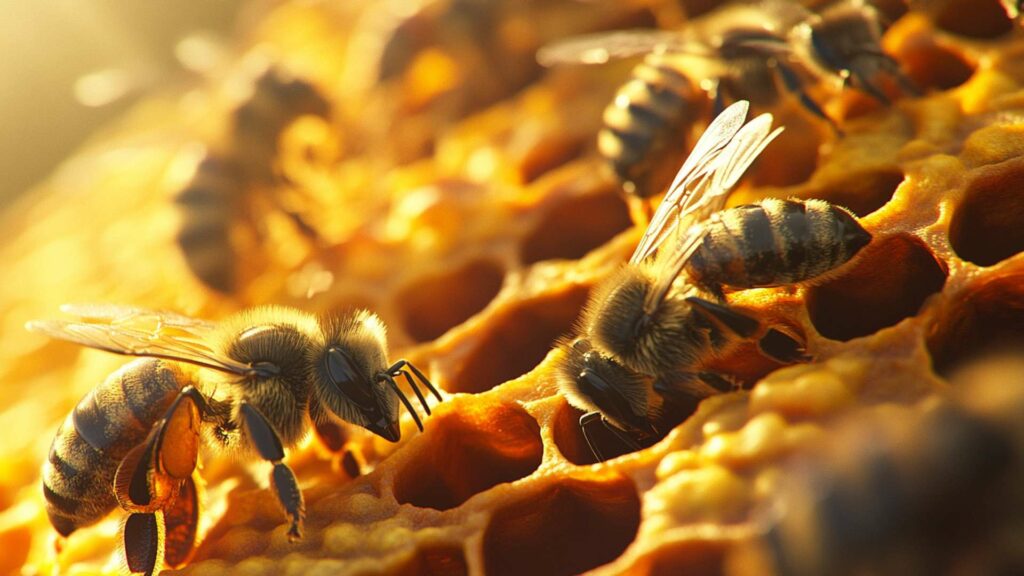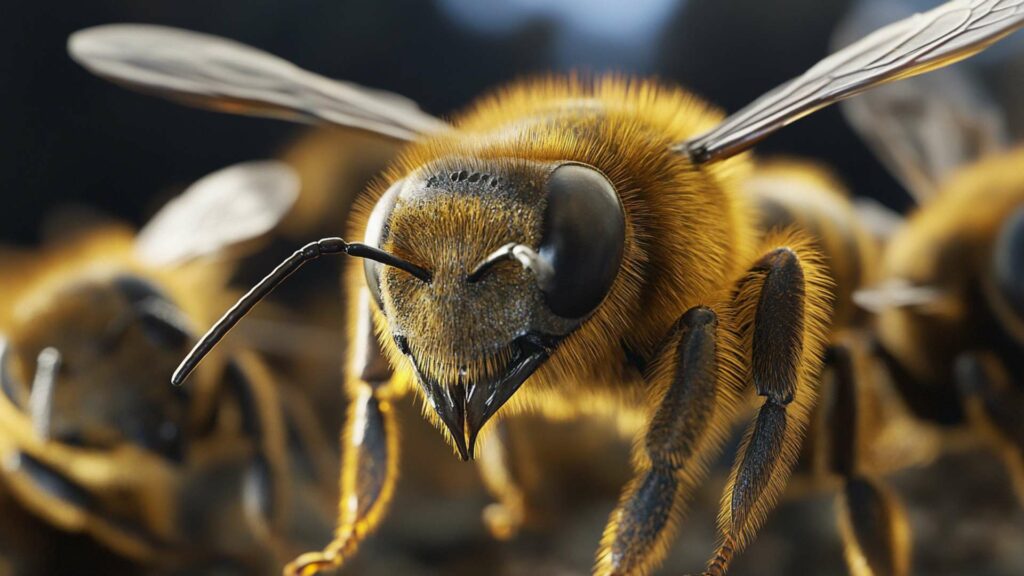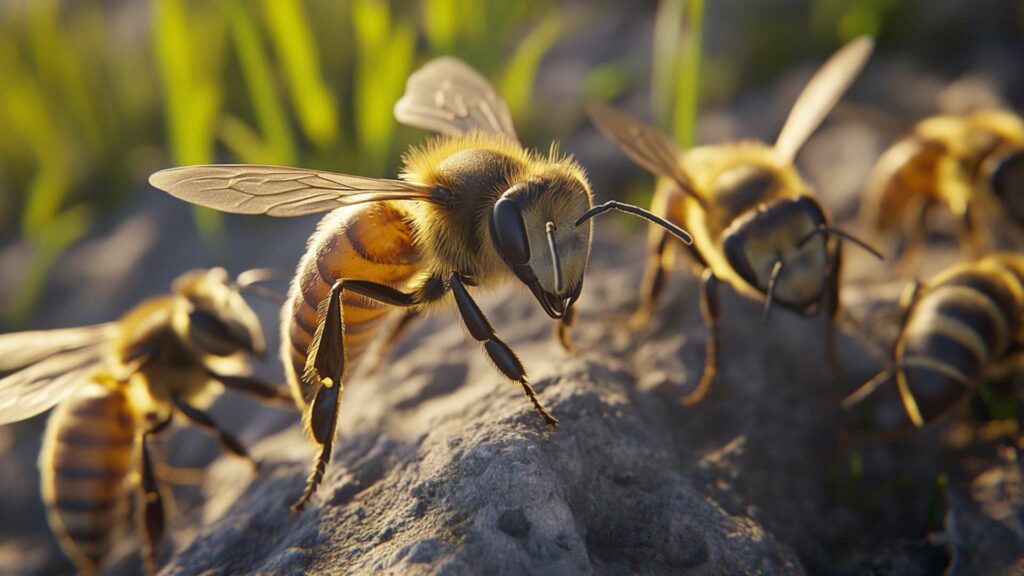Picture the joy of honey’s sweet taste melting on your tongue. Humans have been fascinated by this golden elixir for centuries.
Ever wondered how busy bees make that tasty treat? This article explores the fascinating world of honey-making bees. This article also reveals the intricate process behind their sweet creations.
Fascination with Honey and Bees

Throughout history, humans have been fascinated by honey’s enchanting allure. The Greeks saw it as the food of gods, and Egyptians used honey in medicines and embalming rituals.
Today, we still savor its unique flavor and appreciate its numerous health benefits. And then there are bees – these buzzing creatures that play a vital role in our ecosystem.
Bees create honey and pollinate many flowers and plants crucial for life on Earth. The intricate social structure within a bee colony is awe-inspiring. Each bee has a specific role.
Overview of the Honey-Making Process
How do bees turn flower nectar into honey? Worker bees gather nectar from flowers, bringing it back to the hive as fuel and the raw material for honey.
A worker bee returns to the hive with nectar. That bee then passes it to other workers through regurgitation. This helps evaporate water and enzymes in their stomachs break down sugars.
This enzymatic process helps ripen the nectar into what we know as tasty honey. Enzymes transform nectar into honey. These enzymes are stored by house bees in wax cells called honeycombs.
These hexagonal structures not only provide structural stability but also maximize storage capacity. Once a cell is filled with honey, worker bees seal it with a wax cap, indicating that it is ready for long-term storage.
Intriguing, isn’t it? Join us as we dive deeper into each step of this extraordinary journey. We further try to uncover the secrets of how bees make honey.
The Life of a Bee

Roles within the Hive: Queen, Workers, Drones
In the enchanting world of bees, each member of the hive plays a vital role in ensuring its survival. The queen bee, as her regal title suggests, reigns supreme. She is the mother of all bees in the colony and is responsible for laying eggs.
Her sole purpose is to produce honey and to ensure the continuation of the hive’s population. Workers bees, on the other hand, are the true heroes when it comes to honey production.
These industrious females are equipped with special adaptations. These enable them to gather nectar from flowers and transform it into honey. They have a long straw-like tongue. This is known as a proboscis which they use to collect nectar from various plants.
Their bodies also bear pollen baskets on their hind legs. These allow them to collect pollen while visiting flowers for nectar. Drones have quite a different role in many flowers in this bustling community.
Unlike worker bees who diligently contribute to honey production and other hive tasks, drones are male bees. These bees’ primary function is mating with a future queen bee from another colony. They do not participate in any honey-making activities. They instead rely on worker bees for their sustenance.
Importance of Worker Bees in Honey Production
Worker bees truly deserve our admiration when it comes to honey production. They engage in a process within their bodies that transforms raw nectar into honey.
Once worker bees collect nectar and store it inside their stomachs, an enzymatic process begins. The enzymes present in their stomachs break down complex sugars. They break them into simpler forms simple sugars like glucose and fructose.
This transformation helps ripen the nectar by reducing its moisture content. Afterwards, worker bees transfer this partially processed nectar. They do so between themselves through regurgitation and ingestion. This further aids the ripening process.
This communal exchange of nectar continues until the desired moisture content is achieved. Once the nectar reaches an optimal state, worker bees deposit it into a honey cell. This usaully occurs within the honeycomb.
Worker bees also play a crucial role in evaporating excess moisture from the nectar. This is through a process known as fanning. By fluttering their wings vigorously, they create air currents. These currents circulate throughout the hive. They facilitate efficient evaporation and concentration of sugars in the nectar.
In this way, worker bees demonstrate their unwavering dedication to honey production. Their efforts ensure enough stores for the hive to survive during winter months.
Gathering Nectar
Picture this: a sunny meadow abuzz with the gentle hum of bees flitting from flower to flower. As they dance through the air, these industrious creatures are on a mission to collect nectar. It is their foraging behavior that propels them forward.
Each honey bee colony has designated worker forager bees assigned to gather nectar. These foragers embark on adventurous expeditions. They do so by tirelessly navigating vast landscapes in search of just the right flowers.
How do they decide which blooms to visit? Remarkably, honey bees possess an innate ability to perceive ultraviolet light. This allows them to see intricate patterns and vivid colors invisible to human eyes.
They are particularly drawn to flowers with vibrant hues like blues, purples, and yellows. But it’s not just about appearances—the scent of flowers also plays a key role in attracting honey bees.
As they hover near a blossom, tiny receptors on their antennae pick up volatile compounds released by the plant. The delightful fragrance acts as nature’s invitation for these workers to explore further.
The Ingenious Bee Anatomy: Nectar Collection with Proboscis and Pollen Baskets
Once the worker bee finds a suitable flower filled with nectar, it’s time for some serious sipping! Equipped with its proboscis, the honey bee extends it deep into the flower’s corolla tube. Slurping up as much nectar as possible, an amazing process unfolds within its body.
The liquid is stored temporarily in its own honey stomach. This a separate reservoir specifically designed for transporting nectar back to the hive. This nectar contains water, complex sugars, and trace amounts of essential nutrients.
But the bee’s work doesn’t end there. In addition to gathering nectar, honey bees also collect pollen for protein-rich sustenance.
As they brush against the anthers of a flower while collecting nectar, pollen grains adhere to their hairy bodies. These precious grains are then brushed off. They are then compacted into specialized structures on their hind legs. These are called pollen baskets or corbiculae.
These ingenious baskets consist of curved hairs on the outside of each hind leg. These form a small concave space—a perfect pocket for storing pollen. The worker bee uses its middle pair of legs to transfer the gathered pollen from its body to this basket-like structure.
Once filled, these baskets become colorful mosaics. They carry nutritious yellow or orange pollen pellets back to the hive. In the next section, we will explore how honey bees transform collected nectar into honey. All this happening within the bustling confines of their remarkable hives.
Transforming Nectar into Honey
Have you ever wondered how bees transform nectar from plants into honey? Well, it all starts with their remarkable enzymatic process.
When honey bees suck nectar from flowers and eat it, they store it in an internal structure called the honey stomach or crop. This part of their digestive system is separate from their true stomach. Their true stomach is used for processing food.
Inside the honey stomach, enzymes mix with the nectar to kickstart the transformation. Once a worker bee collects nectar inside its honey stomach, it returns to the hive and regurgitates it to a house bee.
House bees play a vital role in honey production. They absorb regurgitated nectar, and process it with their saliva and enzymes.
This enzymatic magic leads to a chemical change within the nectar. This breaks down complex sugars into simpler ones like glucose and fructose. These smaller molecules are easier for bees to digest. They also will eventually contribute to the sweetness of honey.
Removal of Excess Moisture Through Evaporation
After undergoing this enzymatic process, there’s still work to be done. All this work is to ensure that nectar becomes delicious honey fit for long-term storage. Fresh nectar typically contains a high water content (around 70-80%). This amount is too much for stable storage and could potentially cause fermentation.
To tackle this issue, worker bees need to reduce the moisture with evaporation. Worker bees regurgitate nectar onto wax cells. House bees fan wings over uncapped cells with fresh nectar.
This fanning behavior helps accelerate evaporation. This happens by creating air currents that carry away excess moisture. As the nectar loses water, its sugar concentration increases. This further aids the transformation into honey.
House bees pollinate flowers and continue until moisture is around 18%. Ripe honey is then ready for long-term storage.
In winter, when nectar is scarce, bees rely on stored honey as their main food. Beekeepers harvest surplus honey from hives to share nature’s sweet gift.
The enzymatic process in a bee’s stomach and evaporation to remove excess moisture are crucial in making honey. Next time you enjoy honey, appreciate the journey from buzzing bees to your pantry!
Honeycomb Construction

Worker bees truly are the epitome of industriousness, my dear readers. These remarkable little creatures possess an incredible talent for wax production.
It all starts with a gland located in their abdomen, known as the “abdominal wax gland.” This gland is responsible for producing the wax that magically transforms into honeycomb. When a bee consumes nectar inside her bee’s honey stomach, a series of chemical reactions occur within her body.
The end result? Wax-producing cells are stimulated, and tiny flakes of wax start to take shape.
These young bees then use their mandibles to remove these flakes from their abdomens. They chew them tirelessly until they become malleable and ready for construction.
Intricate hexagonal design and structural stability
Our house bees, after making wax, create something extraordinary—honeycomb! Its hexagonal design, a masterpiece of nature’s geometry, is chosen for efficiency.
Hexagons use less material but store more within each honey cell. This smart design ensures effective use to accommodate maximum nectar.
Moreover, the hexagonal pattern gives strong stability to the comb. How do these tiny architects achieve such precision?
Well, my friends, it’s a mix of instinct and teamwork. Younger bees collaborate to create intricate combs. These serve as storage for their golden treasure—honey!
Their commitment ensures perfect alignment. This forms a honeycomb structure that bears the colony’s weight and stored honey. Now, let’s explore how bees expertly store nectar in these crafted cells.
Storing Nectar in Honeycomb Cells
Once the worker bees have gathered as much nectar as they can, it’s time for storing it in honeycomb cells to begin. The transfer of ripened nectar from bee to bee within the hive is a crucial part of this process.
As a single bee returns with its load of nectar, it regurgitates the liquid into the mouthparts of another bee. This process is known as trophallaxis. This helps spread the collected nectar throughout the colony.
As fascinating as trophallaxis is, another remarkable behavior comes into play when storing nectar – fanning. Worker bees use their wings to create a breeze within the hive. This causes air circulation that enhances evaporation and reduces moisture content in the stored nectar. By diligently fanning their wings near open honey cells, they accelerate water evaporation. This also ensures that the resulting honey has just the right consistency.
Capping the Honeycomb Cells
Worker bees seal honey cells with wax caps to protect the stored honey from contamination and moisture. Their intricate skills in preserving honey are truly awe-inspiring.
Sealing honeycomb cells with wax caps indicates readiness for long-term storage. It shows that the honey has the right moisture content (around 17-18%) for preservation. Once capped, the honey cells are secure until needed, whether in winter or as food for bee larvae.
Harvesting Honey

Beekeepers play a crucial role in harvesting surplus honey. They assess colony health, decide safe collection amounts, and use their expertise to ensure both bees and humans enjoy the delicious results of this collaboration.
Beekeepers, after identifying ripe honey cells, use extraction methods to get the golden liquid. Centrifugal force extraction and crushing comb extraction are two common techniques.
Centrifugal force extraction uses specialized equipment to spin honeycomb frames. This helps in separating honey into a container. Crushing comb extraction involves crushing honeycombs. This releases liquid honey, which is then filtered and stored.
Quality Control & Storage: Bees’ natural preservation through low water content and acidity
Honeybees use natural preservation techniques for quality control. The low water content in their honey prevents bacterial growth. Ensuring its longevity without refrigeration.
Bees add enzymes to nectar, converting sugars into gluconic acid. This gives honey its mildly acidic pH. This acidity, along with other antimicrobial properties, contributes to the preservation.
To maintain the quality and consistency of honey, proper storage is crucial. Honey should be stored in airtight containers at room temperature. Also staying away from direct sunlight. If exposed to cold temperatures, honey can crystallize. However, gentle warming will restore its smooth texture.
Moreover, honey’s low water content prevents fermentation if stored correctly. By following these simple guidelines, you can savor honey for an extended period.
Conclusion
Understanding how honey bees collect nectar and make honey reveals the secrets within a bee colony. Bees collect nectar through trophallaxis, fan it for optimal moisture, cap filled cells, and harvest surplus honey with care. This exemplifies nature’s exceptional ability to create something as sweet and valuable as honey.
This intricate process highlights the collaboration between bees and beekeepers. Both are important in producing nature’s treasured delight. Next time you enjoy a spoonful or drizzle, appreciate the journey that brought that jar to your hands.
Counteract bee concerns with D-Termination: Leading Pest Control in Las Vegas!

Dealing with bee troubles on your Las Vegas property? Rely on D-Termination for expert assistance. Our skilled team specializes in eliminating bee infestations, bringing back comfort and tranquility to your surroundings. Bid farewell to bees—choose D-Termination for reliable pest control today!
Reach out to us at 702-919-6310 or explore dtermination.com to schedule your bee control service and regain control of your space from these bothersome insects.
Frequently Asked Questions:
Honey is expelled from a bee’s mouth.
Yes, bees do eat their own honey.
Bees make honey through a process of collecting nectar, mixing it with enzymes, and then evaporating excess water.
Bees convert nectar into honey through a series of enzymatic changes and water evaporation in the hive.







